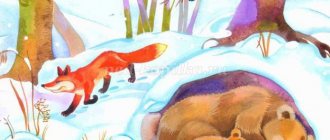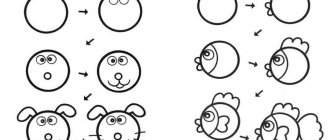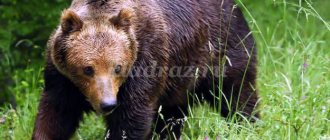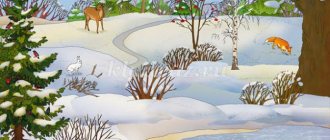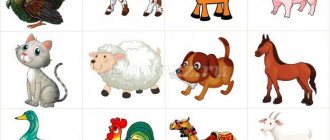Senior group. Senior preschool age. Children 5-6 years old
Summary of GCD classes on speech development in the senior group “Wild Animals” Summary of GCD classes on speech development on the topic: “ Wild Animals ”
in the older group.
Goal: developing word formation skills, clarifying and consolidating ideas about wild animals . Objectives: educational: - systematize children’s knowledge about wild animals , consolidate knowledge about...
Synopsis of an ecology lesson for children of the senior group “How forest animals, a squirrel and a bear prepare for winter” Purpose: To give children an idea of how wild animals (squirrel and bear)
in the forest they prepare for winter, adapt to winter conditions.
Objectives: -Give children an idea that the forest is a habitat for wild animals , squirrels and bears are adapted to life in the forest all the time...
MAGAZINE Preschooler.RF
State budgetary preschool institution kindergarten No. 45 of a combined type, Kirov district of St. PetersburgSummary of direct educational activities to get acquainted with the outside world in the senior group “Wild animals of our forests”
Educator: Osipova S.A.
January 2015
Objectives: 1. To teach children to perceive by ear the figurative content of the story “How they were looking for a little bunny’s mother”; 2. To consolidate children’s knowledge about wild animals; 3. Enrich children's vocabulary on a lexical topic.
Tasks:
Educational objectives: 1) activate vocabulary on the topic “Wild Animals”; 2) learn to answer questions with complete answers; 3) teach to agree in gender, number, case;
Corrective tasks: 1) promote the development of auditory attention; 2) promote the development of coordination of movements, fine and gross motor skills; 3) promote the development of logical thinking;
Educational objectives: 1) strive to cultivate children’s respect for each other; 2) strive to instill in children a sense of love and respect for nature.
Equipment: 1. Pictures of wild animals, 2. wild animal masks, 3. riddles about wild animals, 4. picture of a bear (separate body parts).
Progress of the event:
1. Organizational moment. Let's remember our rule: We always speak beautifully. Correctly, slowly, Whoever wants to talk must pronounce it, Everything is correct and clear, So that everyone can understand.
2. Surprise moment “Letter”. Q: Guys, today I went to our kindergarten and found an envelope in the mailbox, but from whom it was not written. There is a riddle on the envelope, let's guess it, maybe then we'll find out who it's from.
What kind of a guy sat on a twig near an oak tree? He is small, but businesslike, He doesn’t sit in vain: He is without a hammer, without hands He knocks on the trunk: knock-knock. He will find a crack in the bark, stick his long nose into it, and pull out any larva behind the back. That little guy is not simple - he is our forest doctor.
D: Woodpecker B: Well, now we know who this letter is from. Shall we read it? D: Yes Q: Hello, dear boys and girls. There was a problem in our forest, there was a blizzard. The animals have all fled and cannot find their homes. Help me please. And to find the animals, guess the riddles: 1. A ball of fluff, a long ear, Jumps deftly, loves carrots. (Hare) 2. Fluffy tail, golden fur lives in the forest, steals chickens in the village. (Fox) 3. She is small, her coat is lush, she lives in a hollow, gnaws nuts. (Squirrel) 4. In the summer he walks without a road near the pines and birches, and in the winter he sleeps in a den from the frost, hiding his nose. (Bear) 5. Who wanders in the forest angry and hungry in the cold winter? (Wolf) Q: Well done guys, you completed this task. What should we call all these animals? D: Wild animals. Q: We found the animals, and remember, in the letter the woodpecker said that a blizzard swept away all their houses, let’s help find them? D: Yes.
3. Game: “Who lives where?”
Q: Let’s connect a line between a wild animal and its home. D: The bear is sleeping in a den. The wolf lives in a den. The fox lives in a hole. The squirrel lives in a hollow. The hare lives under a bush. Q: Well done and you completed this task. But we still have tasks from the woodpecker:
4. Game “Collect an animal”
Q: When the woodpecker flew to us with a letter, he was carrying a drawing of an animal, but remember there was a snowstorm, a strong wind scattered all the parts of the drawing, let's find and collect them. D: This is a bear's head. This is a bear ear. This is a bear's body. These are the bear's front paws. These are bear hind legs. This is a bear's tail. Q: What animal did we get? D: Bear. V: Well done, you did it. Now it's time to rest.
5. Physical exercise “Wild Animals”
One day the animals were walking along a forest path to a watering hole. A bear cub followed the mother bear, The squirrel cubs galloped behind the mother the squirrel, The slanting hares followed the mother the hare, The she-wolf led the wolf cubs. All mothers and children want to get drunk. (children imitate the habits of wild animals) Q: Guys, look, we find ourselves in a fairy-tale clearing. Let's sit down and listen to a story from a woodpecker.
6. Fairy tale: “Like a bunny looking for its mother”
Q: One day a woodpecker in the forest heard someone crying pitifully. He sat on a tree branch and began to observe. He knew that he needed to behave very carefully in the forest so as not to scare the animals, so as not to harm them. The woodpecker saw that the baby was crying, a small white lump with a small fluffy tail and big ears. He called pitifully, “Mom! Mother!" Suddenly a squirrel jumped onto an oak branch and asked: “What happened?” You are lost? - Yes, I lost my mother. -What is your mother like? Does she have fluffy tufts on her ears? “No,” the baby cried bitterly. A bear waddled out from behind an oak tree and said: “Perhaps your mother wears a shaggy brown fur coat?” “No,” the baby continued to cry. A rustling sound was heard, and a hedgehog rolled out from under the stump. She frowned with concern and said. “I know your mother has thorns on her back.” “No,” the baby continued to cry. The bushes began to move, and a fox came out. -Who is crying here? Does your mom have a fluffy red tail like that? “No,” the baby suddenly laughed. – Where have you seen such a mother: with a fluffy tail, in a brown fur coat, with needles on her back, with tassels on her ears? “Yes, indeed,” all the forest mothers laughed. – What is your mother like? - My mom is the most beautiful! “We know, we know,” the forest mothers began to shout. How good it is to know your mother's signs. And then his mother jumped out into the clearing. The baby rushed to her. She rubbed gently, soothing her cub. How happy all the forest mothers were about this meeting!
Q: Children, do you recognize this baby? D: This is a bunny. Q: Tell me, what is his mother like? D: The hare has a fluffy coat, gray in summer and white in winter. The hare has long ears, slanted eyes, and a small fluffy tail. The hare's front legs are short and her hind legs are long. Q: What animals offered to become his mother? D: Squirrel, hedgehog, fox, bear. Q: Are you glad that the bunny found his mother? D: Yes. Q: You and I found the bunny’s mother, let’s also find the other forest babies their mothers. But before we find them, let's play with our fingers.
7. Finger gymnastics.
A squirrel sits on a cart, She sells nuts (knock on the table with her fists) to the little fox-sister, the she-wolf, the hedgehog, the clubfooted bear, the mustachioed bunny. (Curb your fingers on each animal, starting with the big one) Some in a scarf, some in a goiter, some in a paw. (Pound your fists on the table)
8.Game: "Find Mom."
Q: On the card there are several contour images of forest mothers superimposed on each other, and next to it is an image of one cub. You must circle the picture of the mother whose baby is on your card.
9. Game “What would we treat the animals with?” (Children distribute to wild animals the food they eat)
10. Summary of the lesson. Well done, you worked very well today, you completed all the tasks that the woodpecker suggested to you in his letter. At home, please draw any wild animal for our “Young Ecologist” stand, and ask your parents to help you.
| Next > |
